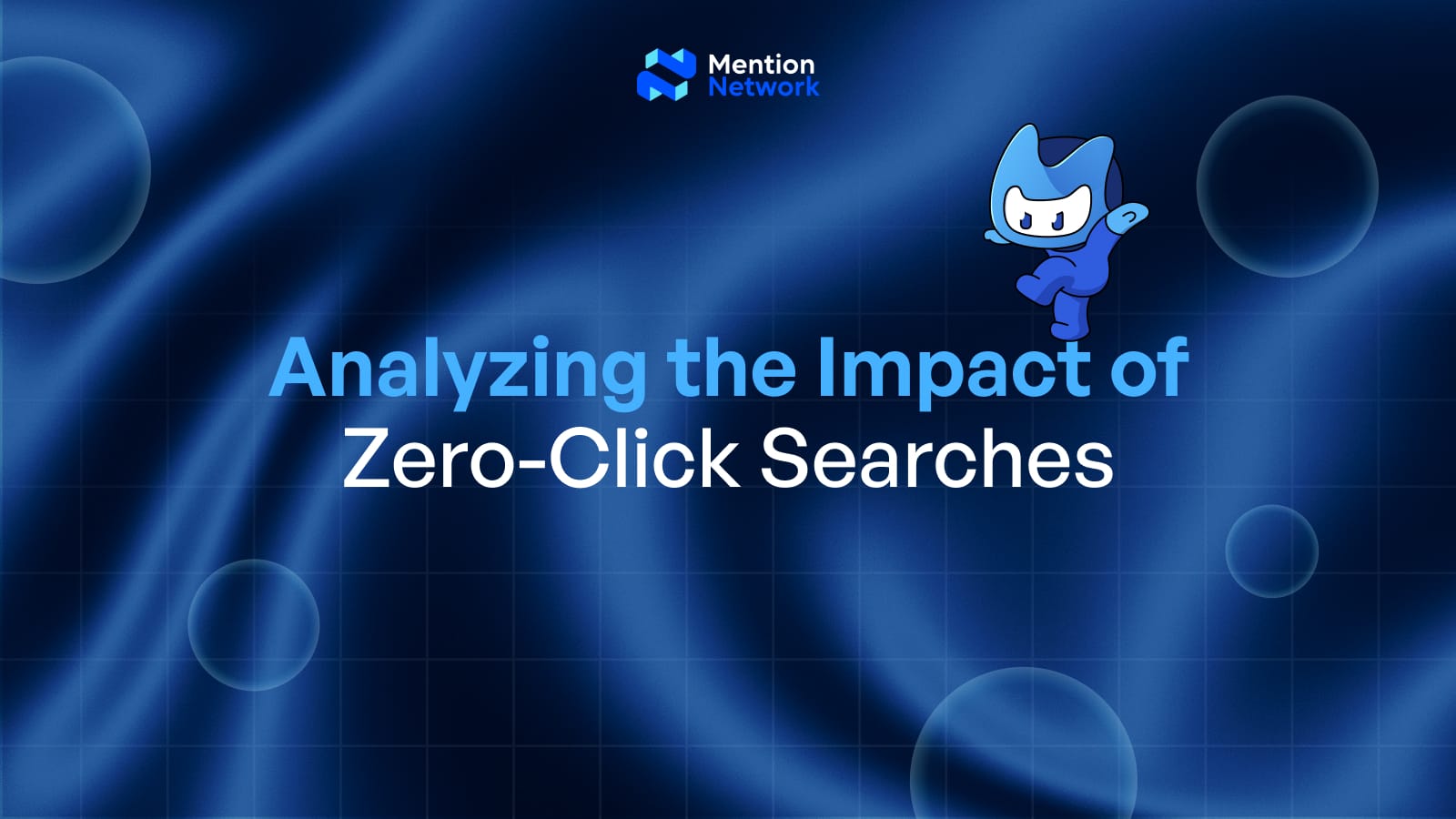Analyzing the Impact of Zero-Click Searches

The search engine results page (SERP) is no longer a simple directory, it's an answer engine. This transformation, driven by rich snippets, knowledge panels, and AI Overviews, has ushered in the era of the Zero-Click Search. For digital strategists, this isn't just a trend it's a fundamental shift demanding a complete strategic overhaul.
In this zero-click searches reality, nearly 60% of all Google searches are resolved directly on the SERP. While this creates a crisis for traditional organic traffic models, savvy strategists recognize a massive opportunity for brand visibility, authority building, and a more direct connection to high-intent users.
This analysis dives deep into the mechanisms, metrics, and mandatory adaptations required to pivot from merely chasing rankings to mastering Search Everywhere Optimization (SEO-E).
- Visibility > Traffic: Success is measured by on-SERP visibility, including impressions and the acquisition of featured snippets and AI Overview citations.
- Modular Content: Content must provide concise, direct answers formatted with lists and tables to be selected for zero-click searches features.
- Structured Data is Key: Implement Schema Markup (FAQ, HowTo, Article) to ensure content displays as rich results.
- Build Authority (E-E-A-T): High Experience, Expertise, Authoritativeness, and Trustworthiness increases your chance of being cited in AI Overviews.
- Local is Conversion: For local businesses, the Local Pack and optimized Google Business Profiles are the conversion funnel.
How Zero-Click Searches Redefine SEO Success Metrics

The traditional focus on click-through rate (CTR) and organic traffic volume is insufficient, modern SEO must incorporate SERP "real estate" and branded exposure as primary success indicators.
Zero-Click searches force a necessary evolution in how we measure content performance. Previously, an SEO report heavily featured sessions, pageviews, and bounce rates. Today, a successful outcome might be zero sessions but a massive boost in "On-SERP Brand Visibility."
When your content is prominently displayed in a Featured Snippet or cited in an AI Overview, you achieve high-value brand exposure. This exposure is especially critical for top-of-funnel queries (awareness and informational stages). Even without a click, the user associates your brand with the authoritative answer.
The Power of Passive Branding
Imagine a user asking, "What is Zero-Click Searches?" If Google displays your definition in a prominent snippet with your site's name next to it, the user has just received an answer, solved their problem, and unconsciously registered your brand as the expert source. This passive branding builds Authority, Trust, and Recall (E-E-A-T), which pays dividends when the user moves to a more transactional, click-worthy search later on. The true GEO success metric is the increase in branded searches and the long-term compounding effect of expertise recognition.
Transitioning to Generative Engine Optimization (GEO) Strategy
To thrive in a zero-click searches environment, content strategy must shift from anticipating the user's click to preempting the search engine's extraction of information.
Traditional SEO often tolerated ambiguity and relied on deep dives that spanned several paragraphs before reaching the main point. GEO demands surgical precision. Your content must be optimized specifically for AI extraction and summary generation.
How to Master GEO Content Structuring
- Direct Answer Formatting: Start key sections with a short, definitive, and bolded sentence that directly answers a specific, anticipated user question (the "BLUF" approach). This is the ideal format for a Featured Snippet or the opening sentence of an AI Overview.
- Semantic Structuring (Schema Markup): This is non-negotiable. Using Structured Data (such as FAQPage, HowTo, Recipe, and Article Schema) tells search engines exactly what each piece of information is, making it easy for AI to confidently extract and cite it. Unstructured data is invisible to GEO.
- Audience-Centric Organization: Structure your content around the likely PAA questions. Each subheading should be a query a user might type or speak. This covers multiple search intents within a single article, increasing the surface area for Zero-Click features.
This strategic formatting ensures that the search engine doesn't have to "guess" which part of your page is the correct, citable answer. It makes the extraction process simple and reliable, thus maximizing your On-SERP presence.
The Zero-Click Searches Intent Divide: Knowing When to Aim for the Click

Not all searches are Zero-Click. Content creators must strategically divide their efforts, aiming for On-SERP visibility for informational queries and reserving click-driving depth for commercial and transactional queries.
Understanding the Search Intent behind a query allows marketers to allocate resources effectively.
The Zero-Click Zone (Informational Intent)
- Examples: "What is the capital of Korean?", "Definition of blockchain," "How long to bake chicken?"
- Goal: Provide the immediate, correct answer directly in the snippet to establish authority. The user is satisfied and usually moves on or performs a new, more specific search.
The Click Zone (Transactional & Commercial Intent)
- Examples: "Best project management software for startups," "Buy blue light glasses near me," "Review of the latest iPhone."
- Goal: The user has a high need for comparison, research, or execution. Google can provide a summary, but the user ultimately requires the depth, comparison tables, user reviews, or checkout options only available on your site.
The strategy here is to use your informational Zero-Click content to build brand trust, which then leads to a branded search or a direct click when the user is ready to engage in a high-value, transactional query. Content for the Click Zone must be detailed, persuasive, and contain unique, non-summarizable value (e.g., proprietary data, unique user reviews, competitive pricing).
Mitigating Revenue Loss: The Funnel of Zero-Click Searches
While Zero-Click can reduce overall traffic, it doesn't have to eliminate revenue. The strategy involves using Zero-Click Searches exposure to qualify leads and drive high-value downstream conversions.
The concern about losing advertising revenue due to fewer pageviews is valid, but the solution is to redefine the marketing funnel. Zero-Click Searches moves the awareness stage onto the SERP and reserves your website for the consideration and decision stages.
Practical Application: The Hook-and-Depth Approach
- The Hook (On-SERP Content): Provide 80% of the answer in the snippet/AIO, establishing credibility and helpfulness.
- The Depth (On-Site Content): Reserve the final, most valuable, and unique 20% of the information for the actual website. This could be a proprietary tool, a comprehensive comparative table, a unique case study, or a call-to-action (CTA) for a free trial.
By ensuring the on-site experience is immediately superior and relevant to the partial answer they just received, you maximize the chance of converting the few, highly qualified clicks you do receive. Essentially, Zero-Click Searches acts as a powerful, free lead qualification filter. The clicks you receive are more likely to convert because the user already knows you are the authoritative source.
Conclusion: The Resilient Content Creator
The rise of Zero-Click Searches is not the death of organic traffic, it is the maturation of search. It presents a challenge, forcing marketers and developers to move beyond superficial traffic gains and focus on deeply understanding user intent and optimizing for the generative power of AI.
The future of search visibility is less about fighting the Zero-Click features and more about collaborating with them. By embracing Generative Engine Optimization (GEO), structuring data meticulously, and strategically reserving high-value content for the on-site experience, businesses can transform a perceived threat into an enormous opportunity for brand authority, qualified traffic, and resilient revenue streams. The click may be scarce, but the value of the impression, the brand association, and the qualified lead has never been higher. The content creator who adapts will not just survive, but dominate the new search landscape.
Frequently Asked Questions (FAQ)
What is the difference between SEO and GEO?
SEO targets high rankings for clicks. GEO structures content for AI citation, maximizing On-SERP Brand Visibility without a click.
Will Zero-Click make websites obsolete?
No. Zero-Click satisfies simple info needs. Websites are still essential for transactions, deep research, and unique services the conversion stage.
Should I block Google from using my content in snippets?
No. Being cited builds authority and free brand visibility. Optimization (GEO) is a better strategy than blocking.

